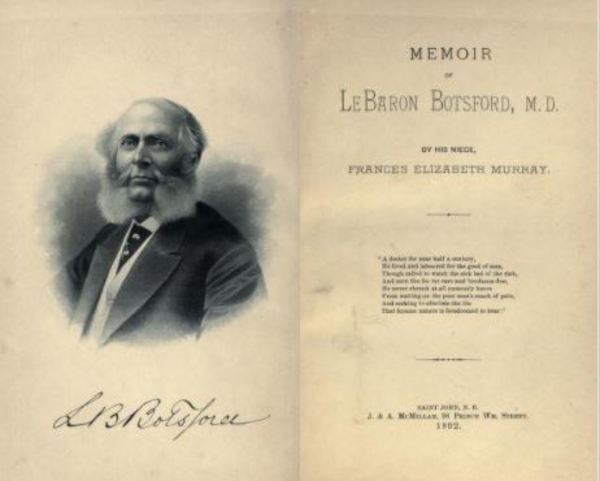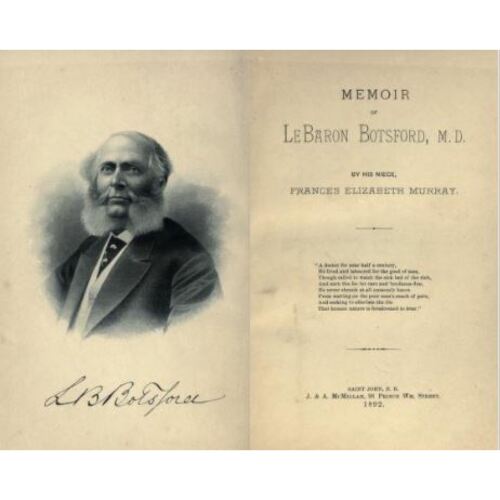
Source: Link
MURRAY, FRANCES ELIZABETH, charitable worker and author; b. c. 1831, daughter of John Thomas Murray and Harriet Letitia Despard; d. 13 Feb. 1901 in Saint John, N.B.
Born into pre-loyalist and loyalist families, Frances Murray was part of the old establishment of New Brunswick. Her father, a lawyer, was clerk of the circuits in Saint John before his early death in 1834. Murray’s mother died in Newport, R.I., in 1867, but Murray is purported to have spent “the greater part of her life” in Saint John in the home of her uncle Dr LeBaron Botsford. From 1880 to 1888 she served as vice-president, and Botsford as president, of the Eclectic Reading Club, a society devoted to “the mutual improvement of the members in reading and their knowledge of general literature.” On the death of her uncle in 1888, Murray was elected president, and she held office until 22 Oct. 1892 when she removed to South Carolina for the winter. In her letter of resignation, she credited meetings of the society with having “done more than we imagine to promote thought, research, discussion, or literary subjects and thus they have helped to free us a little from the everyday cares of our busy lives and to raise us to a higher plane of thought and being.” Her own presentations to the society, ranging from readings of Tennyson’s Princess (1888) and Mrs Margaret Oliphant’s Makers of Florence (1891) to introductions to Charles Lamb (1896) and Julius Caesar (1897), speak of wide literary and intellectual interests. Like her uncle, she was also an enthusiastic member of the Natural History Society of New Brunswick, and she promoted the work of its ladies’ association branch.
A devoted member of the Church of England, Murray taught Sunday school in St Paul’s (Valley) parish; attended Sunday evening service at Trinity, the old loyalist church; was a tireless worker for the Church of England Institute; and at one point studied Hebrew with Bishop John Medley* to improve her Biblical scholarship. It was in other work that she best exhibited her platform and organizational skills, however. In addition to being an active member of the ladies’ committee of the Saint John Protestant Orphan Asylum, she was elected president of the ladies’ auxiliary of the New Brunswick Society for the Prevention of Cruelty to Animals at its inaugural meeting in Saint John on 10 March 1885. Thus she supervised the auxiliary’s initial endeavours to establish bands of mercy for children, sponsor prizes for juvenile writing on humane themes, organize the newsboys of the city into a band of mercy, and give newsboys a Christmas dinner. Her report of 11 Nov. 1886 indicates that she had met with headquarters in Boston on behalf of the auxiliary and that she regularly visited schools to encourage Band of Mercy membership. The interests of the auxiliary began to shift in December 1890 when it was asked to organize a committee to visit such public institutions as the poorhouse and the Provincial Lunatic Asylum and, in anticipation of legislation permitting women to sit on school boards, to elect two possible school trustees. Repeated efforts to facilitate such appointments resulted in the auxiliary’s forwarding the names of Frances Murray and Elizabeth Skinner to the governor-in-council on 29 Nov. 1894, and in the eventual nomination of Mrs Skinner in the late 1890s.
Subsequent to her return from South Carolina Murray’s energies as president were absorbed not only by the school-board issue but also by the auxiliary’s decision to join the Local Council of Women of Saint John, formed after the visit to the city of Lady Aberdeen [Marjoribanks*] on 14 Aug. 1894. Murray was to continue as president of the auxiliary until her death, but as the roles of the auxiliary and the local council became increasingly intertwined, she also served as the latter’s vice-president (1898, 1901) and corresponding secretary (1899). She represented Lady Tilley at the meeting of the National Council of Women of Canada in Toronto in 1895, and at the Victoria meeting in 1900 she influenced the council’s decision to have the national meeting held in Saint John in July 1902. Her sudden death on 13 Feb. 1901 had a significant impact on the auxiliary, which noted in the minutes of 17 Jan. 1902, “Sorrowfully this society finds itself more and more conscious each day of the loss it has sustained . . . and during the past year we have done but little.” At the National Council of Women meeting in 1902, the local council also mourned her absence, remembering “her warm hand-clasp, her eloquence of expression, her wide and varied information, her ripe scholarship, and the cheerful and helpful inspiration of a mind in sympathy with all good works.” The regard in which she was held led the churches, societies, and Local Council of Women to which she belonged to establish a gynaecological ward in her memory in Saint John’s General Public Hospital.
Murray’s love of literature and her skill as a platform speaker were translated into a number of publications in her later life. Her Memoir of LeBaron Botsford, m.d. (Saint John, 1892) claimed to be the first book-length study of a Saint John citizen and was a cathartic work in which Murray explored the social and Christian influences that had informed the life of her beloved uncle. Her 1899 In memoriam: Frederick Hervey John Brigstocke, archdeacon of St. John, also published in Saint John, was both a church and a personal tribute to the friend and rector of Trinity Church with whom she had dined every Sunday evening. “The story of Laura Secord” in Canadian History in December 1898 was written to interest students in their Canadian past, but also reflected Murray’s literary taste in its reference to the play written by Sarah Anne Curzon [Vincent*], Laura Secord, the heroine of 1812 . . . (Toronto, 1887), and in its inclusion of a poem on Secord [Ingersoll*] by Murray’s poet-sister Ellen Murray. Equally representative of her wide-sweeping interests was an essay on “The church work of Protestant women in Canada” in Women of Canada, published by the National Council of Women for distribution at the Paris exposition of 1900. Exploring the developing role of women within Christian education since early settlement, the essay provides insight into Murray’s understanding of the function of organizations in giving women social responsibility and influence. The pattern of her own life reflected this awareness and commitment.
Murray’s article on Laura Secord appears in Canadian Hist. (Saint John, N.B.), no.4 (December 1898): 98–104, one of a series of 12 “supplementary readings” issued quarterly by the Educational Rev. of Saint John between 1898 and 1900, and subsequently published in monograph form as Canadian history readings . . . , under the editorship of George Upham Hay* (Saint John, 1900). Her essay on the church work of Protestant women was published in NCWC, Women of Canada: their life and work; compiled . . . for distribution at the Paris international exhibition, 1900 ([Montreal?, 1900]; repr. [Ottawa?], 1975), 296–302.
City of Saint John, City Clerk’s Office, Common Council, minutes, 6 Dec. 1894, 11 Jan. 1895 (mfm. at N.B. Museum). N.B. Museum, Eclectic Reading Club papers, minute-books, 1880–1902, esp. 24 Nov. 1892; New Brunswick Soc. for Prevention of Cruelty to Animals and Animal Rescue League, Ladies Humane and Educational Auxiliary, minute-book, 1885–1933: 1, 61, 185, 219, 231, 239, 241, 273, 281, 293, 302. Saint John Regional Hospital Arch., Minutes of the board of commissioners of the General Public Hospital, 1, 23 March, 1 June 1901. Saint John Globe, 1, 3 March 1902. St. John Daily Sun, 14, 16 Feb. 1901. R. P. Campbell, Challenging years, 1894–1979: 85 years of the Council of Women in Saint John ([Saint John, 1981?]). T. E. Hazen, The Hazen family in America, a genealogy, ed. D. L. Jacobus (Thomaston, Conn., 1947), 179. NCWC, Year book, 1902, esp. report of the Saint John Local Council of Women (copy in Saint John Regional Library, Saint John Council of Women records, vol.1 (1894–1959)). N.B., The consolidated statutes of New Brunswick, 1903 (2v., Fredericton, 1904), c. 65, sect.4.
Cite This Article
Gwendolyn Davies, “MURRAY, FRANCES ELIZABETH,” in Dictionary of Canadian Biography, vol. 13, University of Toronto/Université Laval, 2003–, accessed April 17, 2025, https://www.biographi.ca/en/bio/murray_frances_elizabeth_13E.html.
The citation above shows the format for footnotes and endnotes according to the Chicago manual of style (16th edition). Information to be used in other citation formats:
| Permalink: | https://www.biographi.ca/en/bio/murray_frances_elizabeth_13E.html |
| Author of Article: | Gwendolyn Davies |
| Title of Article: | MURRAY, FRANCES ELIZABETH |
| Publication Name: | Dictionary of Canadian Biography, vol. 13 |
| Publisher: | University of Toronto/Université Laval |
| Year of revision: | 1994 |
| Access Date: | April 17, 2025 |



